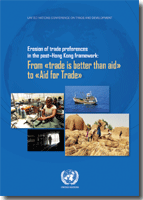
Until recently, trade preferences were part of and instrumental in the paradigmthat trade is better than aid.
The original objectives of the Generalized System of Preferences (GSP) were to:
- increase export earnings
- promote industrialization
- accelerate economic growth
Trade preferences were expected to serve as a catalyst in triggering virtuous circles leading to higher exports and revenues, increased supply capacity and, ultimately, economic growth.
At the World Trade Organization´s (WTO) Sixth Ministerial Conference, heldin Hong Kong (China), the original paradigm — that trade is better than aid — wasalmost reversed under the Aid for Trade Initiative. It is now recognized that tradeinstruments, such as increased market access and trade liberalization, are not per sesufficient to generate supply capacity and economic growth. Amidst such changes tothe paradigm, the preference-receiving countries´ concern about the erosion ofpreferences has remained a constant preoccupation.
Within the framework of decisions taken by the WTO members at the HongKong Ministerial Conference, this study examines the following matters:
- which products and which LDCs and most vulnerable countries benefit most from existingpreferences granted by the Triad (the United States, Japan and the European Union)
- the effects of preference erosion that may follow multilaterally agreed reductionsin most favoured nation (MFN) tariff rates
- the relationship between preference erosion and recent proposals for Aid for Trade and the Enhanced Integrated Framework (EIF)
- the case for improving existing preferences and reestablishingmultilateral principles for the granting of preferences to developing andleast developed countries
| Chapter I examines the issue of preference erosion in the post-HongKong scenario. Chapter II provides extensive trade data and figures at the tariff-linelevel of the country/product pairs that have most benefited from tradepreferences in 2004. This chapter is accompanied by a set of tables,contained in the Annex, with detailed information for years 2004 and2002. Chapter III provides estimates utilizing a partial equilibrium model ofthe losses and gains that LDCs may incur following multilaterallyagreed MFN reduction. Chapter IV examines the correlation between the EIF and Aid forTrade Initiatives with regard to preference erosion. It also provides anumber of suggestions on how to improve existing trade preferences inaccordance with multilaterally agreed criteria. |



